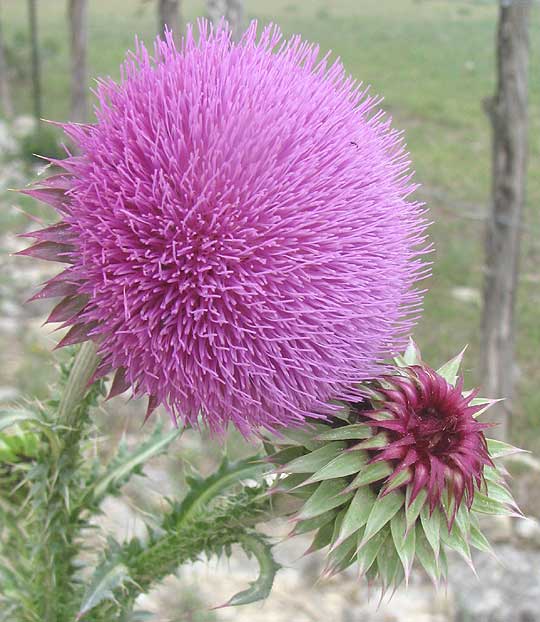Excerpts from Jim Conrad's
Naturalist Newsletter
from the May 19, 2013 Newsletter issued from the Frio Canyon Nature Education Center in northern Uvalde County, southwestern Texas, on the southern border of the Edwards Plateau; elevation ~1750m (~5750 ft); N29.62°, W99.86°; USA
NODDING THISTLES
Along the entrance road the most handsome as well as the most despised wild plant is the one shown below being visited by a Pipevine Swallowtail:

A close-up of a head in full flower is shown below:

This is a member of the huge Daisy or Composite Family, a species that bears no flat, petal-like ray flowers, only cylindrical disc flowers that constitute the head's round "eye." The slender, threadlike items radiating above the spherical head's surface are style branches
Everyone recognizes this surpassingly spiny plant as a thistle. However, there are lots of thistles, since the word thistle is a very general one applied to species in fifteen or more genera. Most people think of any very spiny plant that's a member of the Daisy or Composite Family as a thistle.
In North America's arid central grasslands and scrublands we have several native thistle species that are abundantly spiny, having evolved with herds of grazing Bison in the neighborhood. With their pretty blossoms and special adaptations for the prairies, they are real wildflowers worthy of protection. Mainly these belong to the genus Cirsium, of which maybe 60 species occur in North America. Therefore, here, when you meet a thistle like the one in the photograph, a good first guess is that it's a Cirsium.
However, our Pipevine Swallowtail's thistle isn't a Cirsium. It's a member of the genus Carduus, which embraces about 90 species native to Europe, Asia and Africa. The word carduus is Latin for thistle. Our plant is CARDUUS NUTANS, known as the Nodding or Musk Thistle. And Nodding Thistles are famous as one of the worst weeds in North America. It's the spines that make the plant so undesirable because livestock can't eat the plant, or else injure their mouths trying, and Nodding Thistles can soon take over a pasture as cattle eat everything except them. Nodding Thistles are prodigious reproducers, too, a single large terminal head capable of releasing as many as 1200 parachuted, cypsela-type fruits into the wind. A single plant with several flowers may begat up to 120,000 fruits, which can be carried on the wind for miles. Seed can remain viable in the soil for over ten years.
There's been such concern over the Nodding Thistle invasion that efforts have been made to control it biologically. Two weevil species, the Thistlehead-feeding Weevil and the Rosette Weevil, were introduced in several western US states with some success in killing the thistles. The problem was that the introduced weevils attacked our native thistles as well, including some rare wildflower thistles.
The main botanical distinction between Nodding Thistles and our native thistles in the genus Cirsium is that the hairs forming the fuzz parachute atop the cypsela-type fruits are branched, or feather-like, instead of being simple and unbranched.
Also, notice how broad and backward turned are the bracts, or phyllaries, below the flower head. In our native thistles the bracts are similarly spine-tipped, but their green bodies usually are closely pressed against the head base so that they point upward, not backward as in our Nodding Thistle. Also, among our native thistles of the genus Cirsium the purple-flowered part of the flower head normally is much less expansive than with our Nodding Thistle. A Cirsium flower head is usually urn-shaped, with the purple flowers arranged atop the green, bract-covered involucre below them. You can see that the flowers in our Nodding Thistle overtop the involucre, practically hiding it.
One good thing about Nodding Thistles, though, is that if you put your nose right up to a flowering head, it smells good. Butterflies and other pollinators love the plant. Also, North America's Nodding Thistles don't survive well in habitats that are not highly disturbed.